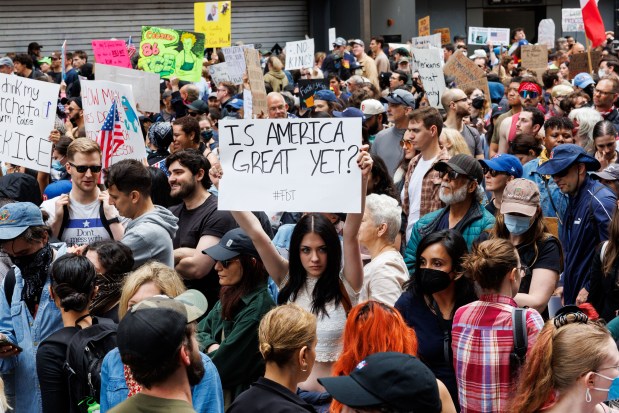Amid the immigrant crisis facing the region comes a tale showcased in Lincolnshire about the hyphenated-American experience. Not that the upscale “olde” village is known for its large immigrant populations.
Yet the other night, the Lincolnshire Marriott Theatre presented “In The Heights,” playwright Lin-Manuel Miranda’s celebration of Hispanic immigrants in the Dominican Republic-flavored Washington Heights neighborhood of New York City, for a sold-out audience.
As is par for the theater, it was a stellar and illustrious performance.
One has to hand it to Marriott producers. They are timely when it comes to the news of the day. “In The Heights” takes the theater’s iconic in-the-round stage through March 17, St. Patrick’s Day, a day of merrymaking for those of Celtic heritage.
A few months later, during the early heat of what is bound to be a contentious presidential election, the theater will offer “1776,” the play which premiered in another formidable year, 1969, and musically details the founding of the nation. That offering runs from Aug. 28 to Oct. 13.
In his introductory notes to “In The Heights,” director James Vasquez points out of the play’s characters: “They fight to remember who they are and where they come from, but also look to the future and dream of who they can become — and ultimately redefine what makes up a family.”
Hopefully, those enjoying the rousing musical and read the director’s ideas sparked their own thoughts of immigration and immigrants, including our latest newcomers, asylum-seekers from Venezuela and other international locales flooding Chicagoland. After all, most of us can trace our ancestries back to forefathers and mothers who left home countries willingly for an ordeal of opportunity and freedom.
Except they mainly came here legally from European nations during the huge waves of migrations in the 19th and 20th centuries, invited by a nation needing cheap labor to fuel the country’s industrialization and claim the western frontier. Waukegan was the proverbial melting pot back then, flush with European emigres seeking their futures.
You could stroll down a bustling Genesee Street and hear various foreign languages being spoken. Walkers would greet each other in their mother tongues, ranging from Greek to Armenian to Spanish to Croatian to Serbian to Slovenian and Polish.
The U.S. is dotted with enclaves, like Washington Heights, of immigrants. The names reflect journeys from home countries: Little Saigon, Little Havana, Little Italy, Irish Hill, Chinatown, Germantown, Tehrangeles, Greektown, Ukrainian Village, and El Barrio. There are many more.
A broad spectrum of new and hopeful refugees have sought the same ideals, albeit illicitly, leaving our political leaders to wrestle with the current invasion at the Southern Border. So far, they’ve done a poor job, turning a public policy issue into a partisan football.
Despite that, Lake County, along with other suburban locations, surely will get a share of these recent refugees. Chicago remains under-resourced to handle the swells of new arrivals shipped north from Texas. Further strains on funding and finances in Chicago and Illinois will continue.
Yet some see a silver lining in this ongoing crush of newcomers. The nonpartisan Congressional Budget Office maintains the surge in immigration may have boosted the U.S. economy, helping avoid a recession. This as the Federal Reserve hiked interest rates sharply last year, and inflation continues to nag at the national economy.
The congressional agency reported earlier this month that over the next decade, the U.S. labor force will be larger by 5.2 million people, mostly because of higher net immigration. More workers and productivity means more tax revenue, along with more demand for goods and services.
So much so that the nation’s gross domestic product between now and 2034 will rise by some $7 trillion and revenues will be greater by about $1 trillion, the agency’s economists predict. According to the budget office, over the same period the U.S. economic output is expected to be about $352 trillion.
Lake County business leaders are familiar with workplace solutions and many probably listened in to a webinar earlier this month for HR professionals, hiring managers and company owners on how to recruit and hire these new arrivals into area workforces. They realize immigrants and refugees are a growing labor force segment.
A bipartisan group of about 1,400 companies, the American Business Immigration Coalition Action also sees the future of immigration. They have urged the administration of President Joe Biden to expand work permits for the long-term undocumented and new asylum-seekers.
They say the crush of newcomers is needed in high-skilled and low-skilled positions in the agriculture, hospitality, healthcare, construction and manufacturing sectors. Which is one of the ways immigration is a boon to the nation.
Just ask the immigrants “In The Heights.”
Charles Selle is a former News-Sun reporter, political editor and editor.
sellenews@gmail.com.
X @sellenews



